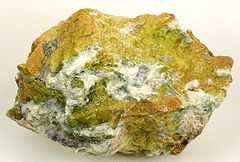Hydrotalcite
| Hydrotalcite | |
|---|---|
 | |
| General | |
| Category | Carbonate mineral |
| Formula (repeating unit) | Mg6Al2CO3(OH)16·4(H2O) |
| Strunz classification | 05.DA.50 |
| Crystal symmetry |
(3R polytype) Trigonal hexagonal scalenohedral H-M symbol: 32/m Space group: R3m |
| Unit cell | a = 3.065 Å, c = 23.07 Å; Z = 3/8; |
| Identification | |
| Color | White with possible brownish tint |
| Crystal habit | Subhedral platey crystals, lamellar-fibrous, rarely euhedral prismatic; commonly foliated, massive |
| Crystal system | Trigonal |
| Cleavage | {0001}, perfect |
| Tenacity | Flexible, not elastic |
| Mohs scale hardness | 2 |
| Luster | Satiny to greasy or waxy |
| Streak | White |
| Diaphaneity | Transparent |
| Specific gravity | 2.03 - 2.09 |
| Optical properties | Uniaxial (-) |
| Refractive index | nω = 1.511 - 1.531 nε = 1.495 - 1.529 |
| Birefringence | δ = 0.016 |
| Other characteristics | Greasy feel |
| References | [4] |
Hydrotalcite is a layered double hydroxide of general formula (Mg6Al2(CO3)(OH)16·4(H2O), whose name is derived from its resemblance with talc and its high water content. The layers of the structure may stack in different ways, to produce a 3-layer rhombohedral structure (3R Polytype), or a 2-layer hexagonal structure (2H polytype) which was formerly known under the name manasseite. The two polytypes are often intergrown.[1][2][4] The carbonate anions that lie between the structural layers are weakly bound, so hydrotalcite has anion exchange capabilities.
It was first described in 1842 for an occurrence in a serpentine - magnesite deposit in Snarum, Modum, Buskerud, Norway.[1] It occurs as an alteration mineral in serpentinite in association with serpentine, dolomite and hematite.[2]
Hydrotalcite has been studied as potential getter for iodide in order to scavenge the long-lived 129I (T1/2 = 15.7 million years) (and also other fission products such as 79Se (T1/2 = 295 000 years) and 99Tc, (T1/2 = 211 000 years)) present in spent nuclear fuel to be disposed under oxidising conditions in volcanic tuff at the Yucca Mountain nuclear waste repository. Unfortunately carbonate easily replaces iodide in its interlayer. Another difficulty arising in the quest of an iodine getter for radioactive waste is the long-term stability of the sequestrant that must survive over geological time scales. Layered Double Hydroxides are well known for their anion exchange properties.
Hydrotalcite is also used as an antacid.
See also
- Brucite, Mg(OH)2
- Fougerite
- Layered double hydroxide
- Magnesium hydroxide
References
- ↑ 1.0 1.1 1.2 [http://www.mindat.org/min-1987.html, Mindat.org]
- ↑ 2.0 2.1 2.2 Handbook of Mineralogy
- ↑ Webmineral data
- ↑ 4.0 4.1 IMA Nomenclature Report
- Jow, H. N.; R. C. Moore, K. B. Helean, S. Mattigod, M. Hochella, A. R. Felmy, J. Liu, K. Rosso, G. Fryxell, J. Krumhansl (2005). "Yucca Mountain Project-Science & Technology Radionuclide Absorbers Development Program Overview". Yucca Mountain Project, Las Vegas, Nevada (US).
- Jow, H. N.; R. C. Moore, K. B. Helean, J. Liu, J. Krumhansl, Y. Wang, S. Mattigod, A. R. Felmy, K. Rosso, G. Fryxell. Radionuclide absorbers development program overview Office of Civilian Radioactive Waste Management (OCRWM), Science and Technology Program.
- Kaufhold, S.; M. Pohlmann-Lortz, R. Dohrmann, R. Nüesch (2007). "About the possible upgrade of bentonite with respect to iodide retention capacity". Applied Clay Science 35 (1–2): 39–46. doi:10.1016/j.clay.2006.08.001.
- Krumhansl, J. L.; P. Zhang, H. R. Westrich, C. R. Bryan, M. A. Molecke (2000). "Technetium getters in the near surface environment". Migration Conference 99.
- Krumhansl, J. L.; J. D. Pless, J. B. Chwirka, K. C. Holt (2006). "Yucca Mountain Project getter program results (Year 1) I-I29 and other anions of concern". SAND2006-3869, Yucca Mountain Project, Las Vegas, Nevada.
- Mattigod, S. V.; G. E. Fryxell, R. J. Serne, K. E. Parker (2003). "Evaluation of novel getters for adsorption of radioiodine from groundwater and waste glass leachates". Radiochimica Acta 91 (9): 539–546. doi:10.1524/ract.91.9.539.20001.
- Mattigod, S. V.; R. J. Serne, G. E. Fryxell (2003). "Selection and testing of getters for adsorption of iodine-129 and technetium-99: a review". PNNL-14208, Pacific Northwest National Lab., Richland, WA (US).
- Moore, R. C.; W. W. Lukens (2006). "Workshop on development of radionuclide getters for the Yucca Mountain waste repository: proceedings.". SAND2006-0947, Sandia National Laboratories.
- Pless, J. D.; J. Benjamin Chwirka, J. L. Krumhansl (2007). "Iodine sequestration using delafossites and layered hydroxides". Environmental Chemistry Letters 5 (2): 85–89. doi:10.1007/s10311-006-0084-8.
- Stucky, G.; H. M. Jennings, S. K. Hodson (1992). Engineered cementitious contaminant barriers and their method of manufacture. Google Patents.